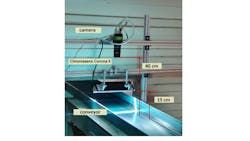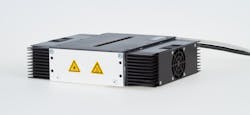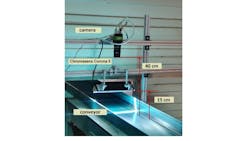Chromasens Lighting System Key Component in Lumber Quality Inspection System
KONSTANZ, GERMANY—Along with current supply chain issues, the wood industry is facing many challenges. In particular, the high variability of raw materials and the complexity of manufacturing processes result in a range of visible defects. These defects all must be found manually, a process that is not only tedious and biased but also ineffective in large production volumes because of factors such as eye fatigue or distraction. Manual inspection of wood rarely achieves 70% reliability at best.
To overcome these drawbacks, researchers have developed an automated inspection system that is accurate and won't slow down the manufacturing process. Based on a Chromasens Corona II illumination system and a trilinear line scan camera, the imaging system can acquire 3 × 4096 pixels per line at the speed of 66 kHz when connected to a Camera Link frame grabber with the transfer speed parameter set to 10 tap mode.
The required field of view for production is a width of 15 cm and the full length of 500 cm and was achieved using the Kowa LM50LF line scan camera lens. The 50-mm focal length lens was placed at a distance of 40 cm from the measured object, leading to a horizontal resolution of 16.66 pixels per millimeter. The final construction was assembled from ITEM aluminum profiles fixed to the production line and the floor, which helped to avoid acquiring blurry images. The imaging system is suitable for high-speed acquisition in the harsh manufacturing conditions of a sawmill.
Since the shutter of the camera was set to 3 μs to ensure the high-speed image acquisition, researchers selected the linear LED light Corona II by Chromasens. A white spectrum of the light was utilized, sufficiently illuminating the desired field of view and providing a light intensity of 3.5 million lux. Chromasens developed a technology to focus LEDs in its Corona II by using elliptical reflectors instead of using lenses, resulting in no color aberration, higher efficiency compared to lenses, and higher power at longer working distances
Testing the System
The heterogeneity of wood material, combined with the complexity of manufacturing processes, can result in various defects, which not only degrade the mechanical properties of the wood such as its strength and stiffness, but also reduce its aesthetic value. Major wood defects include knots, fungal damage, cracks, warping, slanting, wormholes, and pitch defects. The seriousness of a defect, and therefore the grade and the cost of the material, is primarily determined by four criteria, including the size, location, type of the defect, and the purpose for which the wooden product will be used.
To test this new system, a large-scale dataset of high-resolution sawn timber surface images containing more than 43,000 labeled surface defects and covering 10 types of the most common wood defects were examined. For each image record, researchers provided two types of labels allowing semantic segmentation as well as defect classification and localization. On average, there are 2.2 defects per image, while only 6.7% of images contained more than three defects. The highest occurrence of defects, which was captured during the experiment, was 16 defects per image. While still in its experimental and developmental phase, the system produced results of approximately 81 percent success, a major improvement over manual approaches without the cost of specialized labor.
For more information, visit www.chromasens.com.



